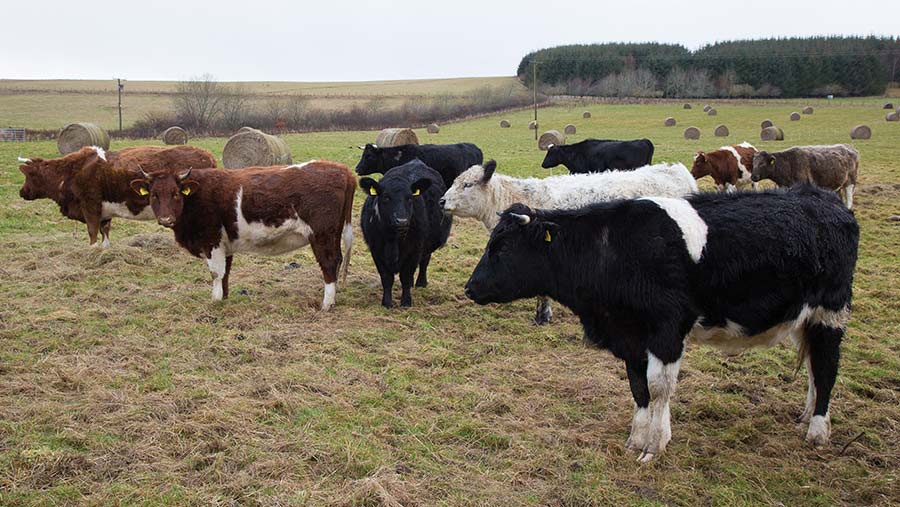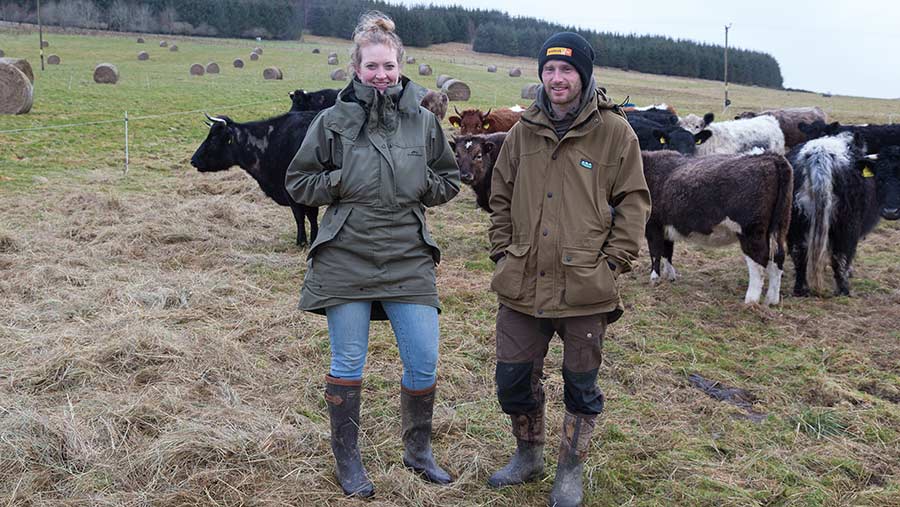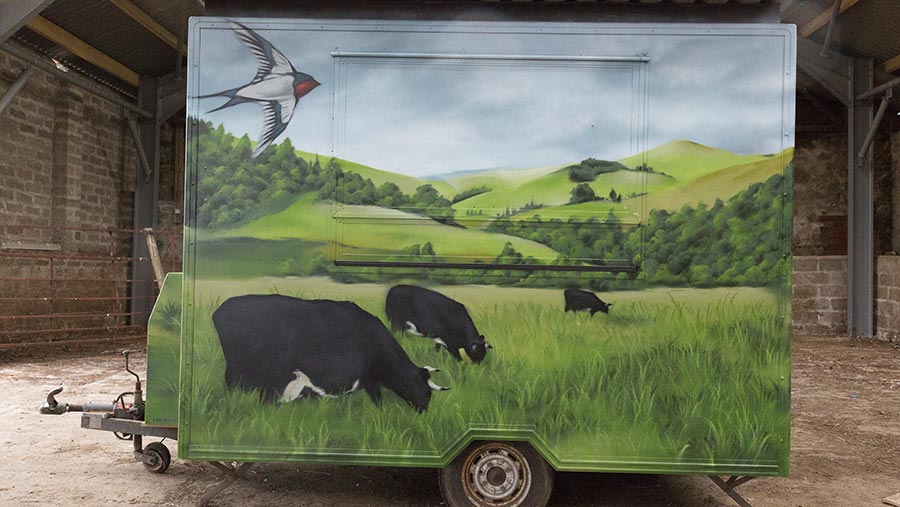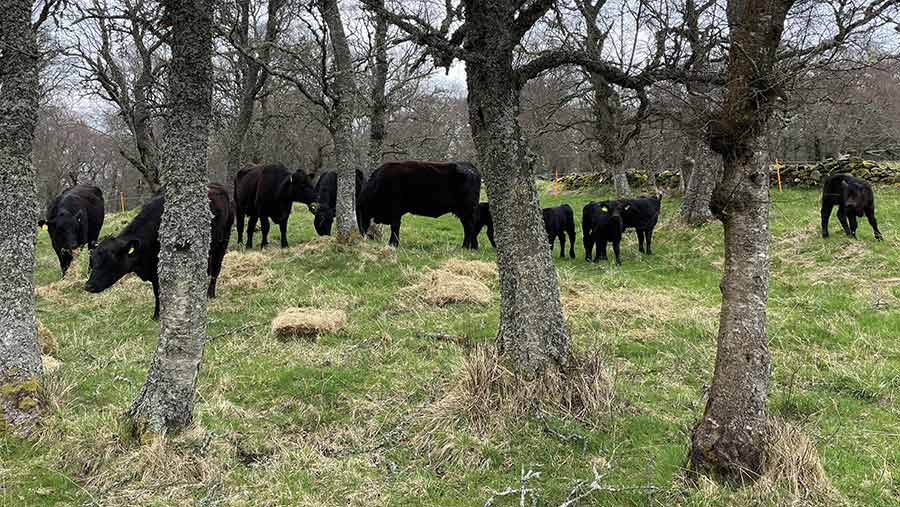How selection pressure is building a resilient beef herd
 © MAG/Judith Tooth
© MAG/Judith Tooth New farming entrants Nikki and James Yoxall take a tough line when selecting replacements for their steadily growing herd of beef cattle.
Faced with more frequent extremes in weather brought on by climate change, and with limited resources, they say their system must be “super-low input” and resilient to make money.
See also: How three breeders market their bulls
The Yoxalls began their farming journey five years ago when they moved to Howemill, a small farm in the Deveron valley in Aberdeenshire, with two heifers.
Rather than buying in more stock to build up their herd, they are breeding replacements based on a tough set of selection criteria.
“This early in the system, it’s about the cow,” says Mrs Yoxall. “As new entrants, we don’t have lots of capital to throw at animals, machinery, sheds and so on.
“We need the animals to do the heavy lifting. Also, as we don’t have long-term access to land, we need animals that can cope with being moved [from one site to another].”
Farm facts: Howemill, Glass, Aberdeenshire
- 7ha (18 acres) species-rich meadows and broad-leaved woodland
- 230-410m above sea level, 700-800mm rain/year
- Small herd of mainly Shetland cows
- Beef all sold locally
- Contract cattle grazing on home farm and other land
- New share-farming agreement on 40ha (100 acres), with starter pedigree Angus herd
- Cattle 100% pasture-fed and outwintered on deferred grazing with hay bales
Selection pressure
To remain in their herd, a cow must get pregnant, hold the pregnancy, suckle her calf, hold body condition, get back in calf, have good feet and not suffer from mastitis.
“We’re asking a hell of a lot, but our whole approach is to develop strong genetic resilience, because [climate change means] extreme conditions are becoming more frequent,” she says.

Nikki and James Yoxall © MAG/Judith Tooth
“If you prop up animals when they’re struggling – put them in a shed, give them supplements and so on – rather than addressing the root cause, it becomes really expensive.
“Our cattle have to perform off what is available. So, for example, we don’t reseed pastures.
“We’re trying to improve soil diversity via [species-rich] hay bales, so we’re tweaking things, but we don’t do any ploughing. It’s a nuanced and sympathetic approach to land management.”
With cows, calves and in-calf heifers, the predominantly Shetland herd is now 28-strong.
Originally a crofting breed, Shetlands are small, very hardy, maternal, have a good temperament and are locally appropriate, say the Yoxalls.
However, they are now switching from a Shetland to an Angus bull to introduce hybrid vigour into future replacements and act as a terminal sire.
Grazing benefits
Prompted by neighbours looking for additional grazing, they set up Grampian Grazing, looking after other people’s stock at Howemill and on other land including the nearby 349ha (862-acre) Beldorney estate, owned by Highlands Rewilding.
Regenerative food production is an integral part of this estate’s plans, with cattle used to improve soil health and diversity as well as producing beef.
The Yoxalls’ herd spent the winter here on land cut for hay last summer.
Two-thirds of the bales were left where they came off the baler, while the remaining third was replaced with species-rich hay from a local RSPB reserve. The hay was fed along with deferred grazing, as needed.
“The hay keeps the cattle warm by firing up the rumen on a cold day and optimising rumen function to use fibre and protein – and the protein doesn’t go through them too quickly,” says Mrs Yoxall.
The herd moved off the winter routine in early April to spend two weeks grazing 0.6ha (1.5 acres) a day before moving to the calving paddocks.
The six-week block of calving begins in early May. Most fields are grazed a maximum of three times a year, with some grazed just once for conservation reasons.
“Our whole way of working is to increase diversity and abundance in the landscape using adaptive grazing and a holistic management framework for decision-making,” she says. This approach to grazing management also considers ecological, economic and social factors.
“We carry out dung scores, forage analysis and mobility monitoring. We will treat individuals, but overall, we want a strong and resilient herd. So far, it’s worked as we’d hoped. But we are right at the start of our journey.”
Local demand
Finishing target is about 300kg deadweight at 26-27 months; older than 30 months significantly impacts profitability.
Their beef is only supplied locally, to reduce food miles and serve the local community. Any interest from potential customers further afield is redirected to producers local to them.
“There’s no point in competing: many more opportunities come from collaboration than from competition,” argues Mrs Yoxall.

Burger van painted with scene of cattle grazing © MAG/Judith Tooth
In a bid to connect with more local people, the Yoxalls have recently restored a mobile catering unit with funding from Scotland Food and Drink.
Mr Yoxall says: “Food access is really important [to us] – many people in our community wouldn’t [normally] buy our produce, but would come out and buy a burger.”
New projects
The current setup does not pay a full-time salary, but neither is it a full-time job.
“It’s profitable for the hours we put in, and we don’t claim any subsidy,” says Mrs Yoxall, who also works part-time as head of research at the Pasture-Fed Livestock Association.
Mr Yoxall, formerly a classic car mechanic, studied agriculture at Scotland’s Rural College Aberdeen campus and works part-time as head of regenerative agriculture at Highlands Rewilding.
“Our aim is to increase herd size and become closer to full-time,” says Mrs Yoxall.
“We wouldn’t do this if it didn’t make financial sense – that’s part of [our] holistic management [approach].
“With more beef boxes, we can sell beef more frequently to the same customer bases, and supply to more restaurants.”
They have recently expanded their operations with a share-farming agreement on a neighbouring 40ha (100-acre) farm.
For this venture, producing 100% pasture-fed breeding stock for sale, the neighbour is providing the land, the two parties share the cattle, and the Yoxalls are supplying most of the labour, expertise and handling equipment.

© Nikki Yoxall
The first six pedigree Angus cows arrived in February and calved in March.
“They’ve come from systems that don’t provide too many crutches – ideally outwintered, not too routinely medicated, and grass-fed as far as possible,” says Mrs Yoxall.
“We will apply the same selection pressure to this new herd – we need more people breeding animals that thrive in low-input systems.”
They are among six farmers taking part in an Innovative Farmers field lab testing the impact on soil health and forage quality of bale grazing.
For the next four years, the farms will take soil samples in summer after the ground has recovered from winter grazing to look for changes in soil carbon, nitrogen, potash, phosphate and electrical conductivity [a measure of salt content], and carry out forage analyses.
The aim is to find out if bale grazing has benefits beyond not having to house stock over winter.
Benefits of holistic planned grazing at Howemill
- Planning the year’s grazing with built-in contingencies creates a feed budget and gives peace of mind
- Health checks can be made during daily cattle moves
- Rest periods between grazing allows plants to grow tall and roots to go deep. This builds resilience for drought, protects the soil from heavy rainfall and creates a stockpile of grass
- Once cattle are trained to the electric fence, they are very easy to move, and individual animals can be drawn out without fuss
- Long rest periods create space for ground-nesting birds and other wildlife to thrive
- Short bursts of grazing stimulate plants to regrow and deploy root exudates that contribute to healthy soil
- The same approach can be used in winter with deferred grazing and bale grazing
